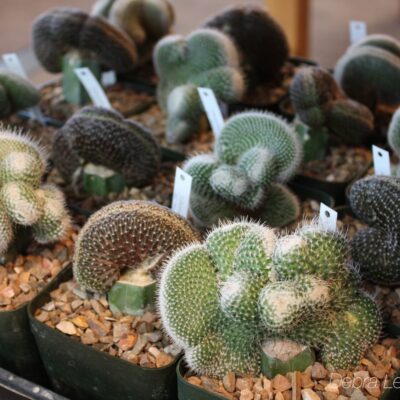Will you help me solve a mystery? I'm wondering why someone would hide valuable, collectible cacti (Gymnocalycium mihanovichii variegata) in a pastry box and ship them to me from overseas.
Eight months ago
In mid-December a package from Thailand arrived with no explanation. Inside was a box of commercial pastries similar to Hostess cupcakes. I assumed it resulted from a translation error on an overseas order. Cleaning up after the holidays, I was about to throw it away when I noticed it had been resealed.

Thai pastry box with gymnocalyciums (after I unwrapped and potted them).
I opened the box and pulled out something round, firm and wrapped in paper towels. (I figured Thai food packaging standards must be pretty lenient.) OMG. There were three spherical cacti with desiccated roots...along with several prepackaged pastries. The largest cactus was the size of a tennis ball.
I recalled that on Instagram Thai nurseries post photos of gorgeous gymnocalyciums with rainbow-sherbet hues. These were probably similar, but weeks of darkness had muted their colors. At least they were alive (they felt firm) and hopefully would grow new roots. I potted them---basically, set them atop moist cactus mix---placed them in bright shade, and gradually introduced them to greater sun to bring out any colors.

Thank-you note for the gymnocalyciums
I searched online for gymno growers in the city they came from. I found several but no leads. Perhaps---as indicated by the return address---they had come from an individual? I didn't eat the pastries (I wasn't curious, not to mention the carbs), but I did air-mail a thank-you. No reply.
So, what's your theory?
I'd love to know your thoughts on this. But rather than emailing me, kindly leave a comment below so others can read it and discuss. And should my benefactor see this: S̄wạs̄dī thī̀rạk (hello, dear one).
Gymnocalycium: What you need to know
Gymnos that lack chlorophyll are sought-after because they show colors otherwise concealed. But less chlorophyll means less ability to photosynthesize (use the sun's rays to produce energy for growth). To keep all-red, yellow, pink or orange specimens alive, commercial growers graft them onto green Hylocereus (dragon fruit) cactus, resulting in "hotheads" or "moon cactus" commonly sold in nurseries.

Each Gymnocalycium mihanovichii (moon cactus, hotheads, lollipop cactus) shares its green rootstock's vascular system.
Although popular with newbies, such grafted cacti are tricky to grow. The rootstock needs sunlight, but the graft (scion) scorches easily. Also the rootstock grows faster than the graft, and eventually they'll split apart...so the scion, to survive, requires re-grafting. [Would you like a post on how to graft cactus? Let me know in a comment below.]
No wonder variegated "mutant" gymnos that don't need grafting are surging in popularity. Like those I received from Thailand, they're fine on their own roots. Plants blend green with brown, purple, red, pink, orange, yellow and/or cream. Each specimen is unique.
Gymnocalycium at a glance
- Spherical and spined
- Symmetrical bumps and ribs
- 70+ species from South America
- Attain 1/2-in. to 8-in. in diameter
- Flowers are warm colors and pastels
- Needs sun to grow and bloom
- If no chlorophyll, have to be grafted to survive
- With chlorophyll, can grow on their own roots
- Less green means greater sunburn risk
- More green means a more vigorous plant
- Needs coarse, fast-draining soil
- Soil should go dry between waterings
- Don't water when dormant (winter)
- Prone to mealybugs and root rot
- Keep above 50 degrees F
- Propagate from seeds or offsets
How they're doing

Gymnocalyciums from Thailand eight months after unboxing and planting
By mid-July the mostly red one---the smallest---had only a few threadlike roots. No change or bloom. The purplish one grew a few roots, flowered, and set numerous buds. The third turned shades of yellow, red and orange mixed with green, established roots, sent forth pale pink flowers, and produced several small offsets (moons).
USA sources:
Mountain Crest Gardens for grafted Gymnocalycium mihanovichii cuttings
Leaf & Clay for purple moon cactus
Succulents Box "Britton & Rose Cactus" (a pinkish-green gymno growing on its own roots)
Amazon: Gymnocalycium mihanovichii variegata seeds

Seed-started gymnos vary considerably. It must be fun to see what pops up. (Amazon photo)
Do you happen to know...
- A good source of non-grafted, colorful, variegated gymnos for the US market?
- How long it takes a seed-grown, variegated gymno to show its colors and attain several inches in diameter?
- How to go about obtaining mature specimens from overseas growers?
Please share your comments, ideas and answers below. Thanks!
Why Cactus is Popular
Long a pariah plant, cactus is gaining popularity. You could even say that in the gardening world, “cactus is the new black.” Here’s why spiny succulents are catching up with smooth ones, notably in art, home decor, clothing and gift items. A little perspective: The first edition of my book, Designing with Succulents (Timber Press,…
I Come Out as a Cactus Lover
When profiled by Garden Design magazine, I took the opportunity to come out as a cactus lover. Well, I had to. They asked about trends in the world of succulents. I believe my progression is fairly typical. Most of us start out loving succulents that look like fleshy roses—echeverias, graptoverias and the like. As people gain appreciation for the…
Cactus Details, Photos and Varieties
Cactus Care, Gallery and Names All cacti are succulents, but not all succulents are cacti. They’re an acquired taste, but once hooked (forgive the pun) you’ll collect more and more. About Cacti Native to deserts and dry regions of the Americas, cacti are succulents at their simplest: a water-storing body and vestigial leaves (spines). These…
The post Hidden Gymnos: My Thai Succulent Mystery appeared first on Debra Lee Baldwin. Copyright © Debra Lee Baldwin.
from Debra Lee Baldwin https://ift.tt/2GpWj2S
via IFTTT




No hay comentarios:
Publicar un comentario